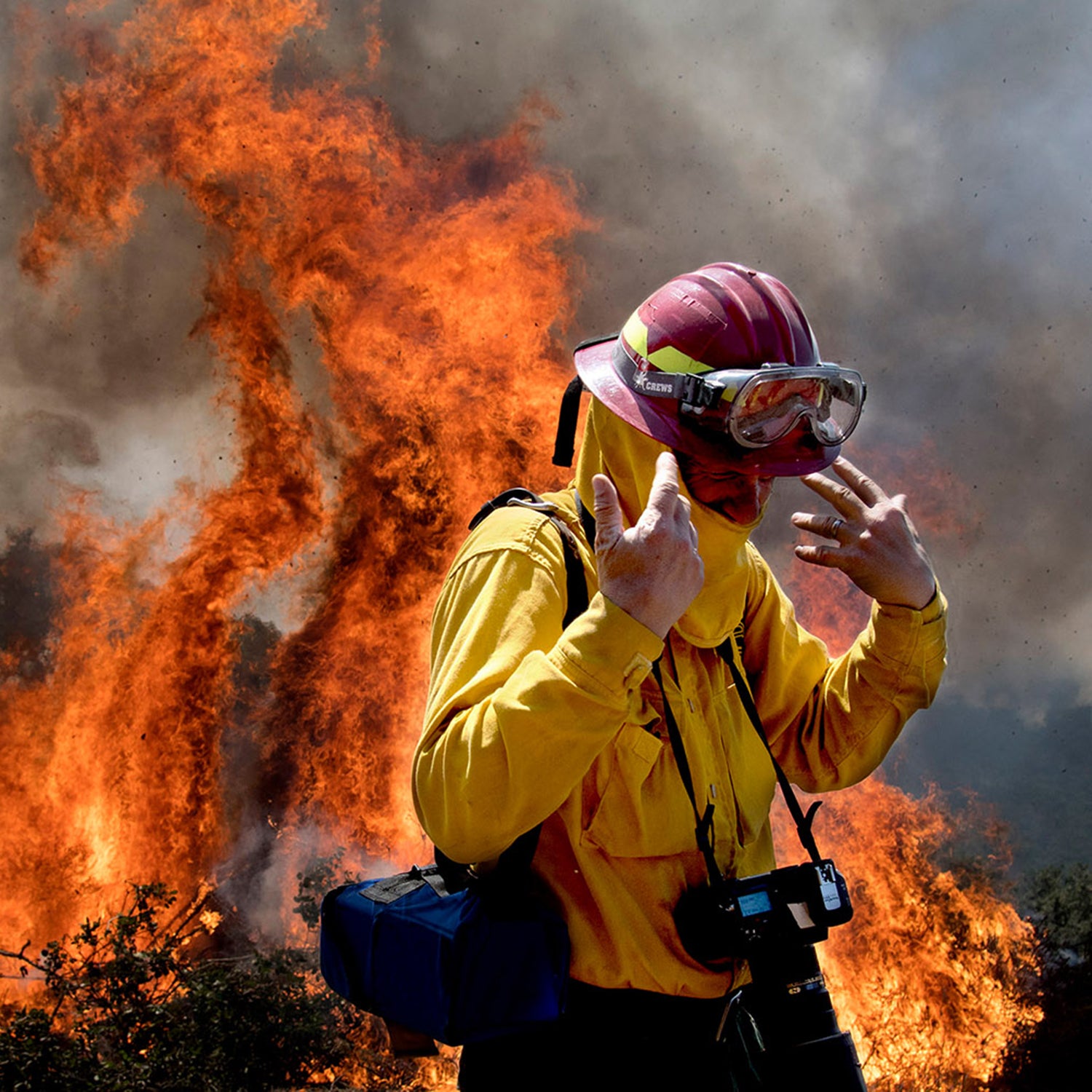Earth, water, fire, and air: the four elements essential to life in Western philosophy, each functioning in unison with one another. But there’s a final element that is throwing the others perilously out of whack, one that the Greeks failed to account for.
, a documentary from filmmaker Matthew Testa and photographer-cum-environmental-activist James Balog (the lens behind the 2012 documentary ), adds humanity to the equation. “We’re a force of nature, too. People are changing the elements, and the elements are changing us,” Balog says in the film, while snapping stills of a dilapidated seaside home likely fallen victim to rising seas.��By appealing to both emotion and rationality, Balog hopes to paint “human tectonics” as the most important of them all,��showing that climate change isn’t some pie-in-the-sky problem for future generations, but is affecting real people, right now.
The film, which streams on platforms like��iTunes and Amazon starting January 29, follows Balog on a years-long traverse of the country looking for characters through which to tell the climate story, from hurricane refugees fleeing rising waters to a family in Denver whose breakfast of potatoes and eggs comes with a side of asthma medication. It’s a departure from An Inconvenient Truth-esqe portrayals of doom and gloom that have defined most climate documentaries of the past decade or so. Rather than featuring primarly scientists preaching to the enviro choir, it focuses on relatable everyday people being affected by the changing planet: firefighters, fishermen, coal miners.
The concept was born partly from the acerbic atmosphere that arose during the 2016 election. “We were looking at a very divided country,” Testa says. “A country with a lot of people whose voices matter, whose votes matter, who didn’t seem to be getting the message about environmental issues.” Underscoring his point is last year’s from the , stating that while 70 percent of Americans believe global warming is happening, only 39 think it’s harming people in the U.S. right now. For this reason, Testa felt it was imperative to tell a story that showed how climate was impacting working Americans, and “speak to a crowd that hadn’t been spoken to yet when it came to this issue.”
“So we have to find a way through that secures a future for people. And I think that’s a message maybe the environmental community would be wise to embrace.”
The film’s most memorable��subject is James “Ooker” Eskridge, the mayor of Tangier Island, a sliver of sand and peat nestled in��Chesapeake Bay, Virginia. Like most of the island’s male inhabitants, Eskridge is a commercial fisherman. But the same waters that give the place life are swallowing it whole. Thanks to rising seas, in 25 to 50 years��Tangier will become the next Atlantis. Eskridge, shadowed by a gaggle of cats he��named��after conservative heroes (John Roberts, Ann Coulter) recognizes his home’s situation is dire, and calls for an estimated $100 million sea wall to encircle the entire island of 700 or so��people. “We don’t have years to wait,” Eskridge says. “We need the help and we need it pretty quick.”
The film presents the people of Tangier as what a resident Army Corps of Engineers scientist calls��the canary in the coal mine��for what will happen to other low-lying coastal��cities as sea-level rise continues, which will come with much higher price tags. (The movie estimates Miami will need $413 billion to adapt to rising waters.)
Tangier represents the water element. Balog goes on to tell��the story of the other three elements through the lens of the fifth, using personal stories to illustrate overarching themes: the asthmatic Denver family for air quality, wildland firefighters in California for rising temperatures, and Appalachian coal miners for fossil fuels.
The final human element of Balog’s countrywide tour is the most poignant. He returns to Vintondale, Pennsylvania, where his coal-miner grandfather was killed in a rockfall in 1946. While snapping photos of his father holding old family portraits and visiting a memorial to people killed in the mine, Balog wrestles with the irony that his career as an environmentalist was built in part on the shoulders of the fossil-fuel industry. “There was always somewhere deep in my heart where I felt like I was somehow tainted because my grandparents were coal miners.… You grow up to be an environmentalist and you go, Coal is a dirty thing,” Balog says in the film. “But there is a nobility in the hard work and courage and the sacrifice of these people doing what they had to do.”
With this, the film��displays its strongest message: there’s nobody holier-than-thou in the climate equation. “None of us stand outside this hydrocarbon economy,” Balog��told me. “Certainly none of us who dress in Gore-Tex, have fancy��expensive backpacks, and jump in our beautiful all-wheel-drive vehicles at a moment’s notice to go run off and chase another outdoor sport. And the sooner we get our shit together and we recognize that, then there might be a chance to fix this.”
Almost as if to provide that chance, the��movie ends��on��an��upswing, following a coal executive in Pikeville, Kentucky, who hopes to revive the area’s economy by building a solar farm atop a reclaimed mine. It hammers home the point that in a crusade to save the other four elements, the fifth can’t be left behind. “Regardless of your [environmental] stance, as Americans we want everyone in the country to be prosperous,” Testa says. “So we have to find a way through that secures a future for people. And I think that’s a message maybe the environmental community would be wise to embrace.”
With this, the film displays��its strongest message: there’s nobody holier-than-thou in the climate equation.
Testa��and Balog’s goals go far beyond just spreading awareness. They’re hoping for what’s known in the environmental filmmaking world as the Blackfish��effect,��referring to the documentary about captive killer whales that was it created a literal sea change. So��Balog, Testa, and the crew are embarking on an outreach tour that will head to��places often neglected by the environmental movement—places like Louisville, Kentucky. At a screening there for coal executives, the film received a standing ovation.��“[A coal executive] actually came up to me and said ‘I liked 90 percent of your film … I think you guys did an amazing job,’”��Balog says.
While I don’t know which 10 percent the coal exec didn’t like, I have a hunch that it’s the same thing the film leaves unaddressed. Throughout, none of the main subjects are asked directly��whether they believe climate change is the root cause of their strife—and, importantly, whether it’s the result of human activity. Most people on Tangier, according to Testa, don’t believe in climate change and think the island is disappearing as a result of erosion. It seems unlikely their concerns would translate into votes for climate policy.��This is problematic. A��recent from the suggests that far-reaching policy changes must occur over the next two decades to limit the negative effects of��global warming. Bringing the film to these kinds of audiences is a step in moving the needle, but it’s uncertain whether this will translate into actionable change.
Where The Human Element could be most effective, however, is in mobilizing the green community. By humanizing climate change��it could provide that extra push needed for on-the-fencers or the eco-minded but idle (looking at you, ) to make their voices count. “What I want is not necessarily to have people come away with a bunch of facts at their fingertips that they can bring to the Thanksgiving table for an argument with their angry uncle, but to look inward and say, ‘How am I being impacted?’” Testa says. Balog is more blunt.��“I want people to look in the mirror and wake up.”
Will The Human Element convince hard-scrabble coal miners to hold hands and sing Kumbaya with Gaia-loving Boulderites? No guarantees. But it tells a powerful story that puts the focus on climate change where it should be: not as a political or environmental issue, but a human one.


